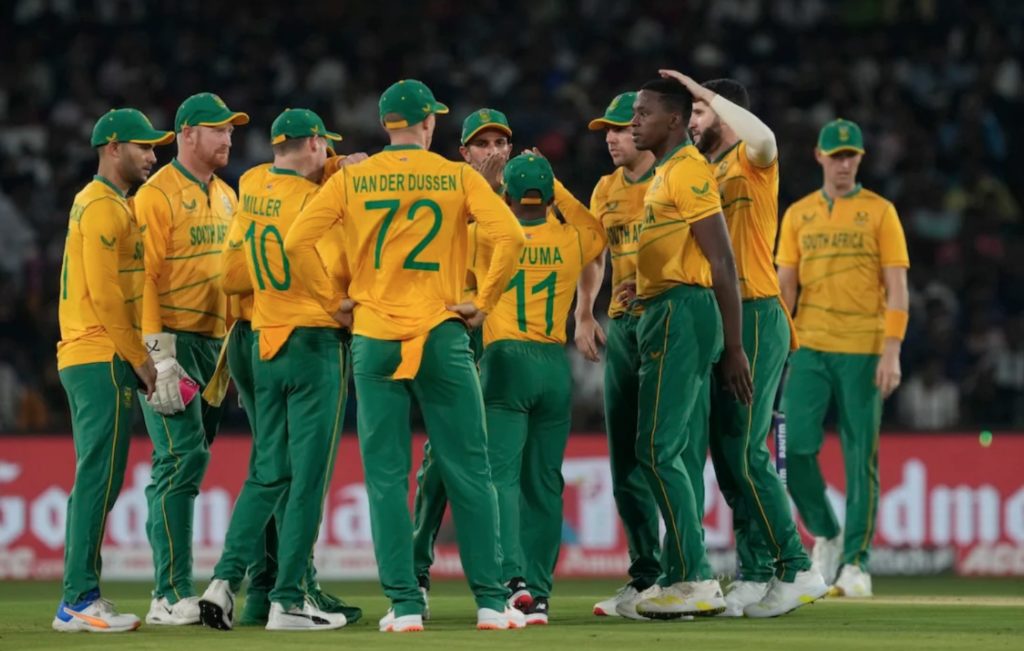The Proteas clobbered India in Cuttack in a performance laden with lessons. RYAN VREDE examines the five standouts.
The Proteas made it two wins on the bounce and now have to win one of the remaining three matches to win the series. India are the world’s top-ranked T20 side and playing at home. This has to inform any appraisal of the Proteas’ performances, which have been excellent.
Many India fans have pointed to the absence of a clutch of stars, including Rohit Sharma, Virat Kohli and Ravindra Jadeja, as the primary reason for their side’s relative mediocrity in the series to date. This is not without merit as an argument, but the Proteas have been clinical nonetheless.
Consider also that they have been without the world’s third-ranked T20 batsman, Aiden Markram (Covid), while Quinton de Kock, widely considered one of the format’s most destructive batters, missed the second match with injury. Furthermore, half the team has been inactive for nearly three months, while many picked up in the IPL auction either didn’t play at all or played very limited roles.
Viewed through this lens, the Proteas have done superbly. There are still some concerns, but none that can’t be addressed in the eight matches that remain before the World Cup.
1. Rabada is magical when in the mood
Kagiso Rabada was utterly unplayable on a helpful Cuttack wicket. He went at an astonishing economy rate of 3.75 and showed why he was picked up for nearly R18-million at the IPL auction.
Rabada has been frustrating at times in recent years. He has gone through entire Test-match sessions looking disinterested and significantly down on speed. Test skipper Dean Elgar even admitted to having some strong words with him for this exact reason, in a break between sessions when India toured for the summer series recently. It’s inexplicable that a professional possessing of such a potent gift would go through periods like this.
However, when he is feeling it, no batter in the world has a rebuttal for Rabada. In Cuttack, he bowled quickly and with vast degrees of skill, control and intelligence. If he can find a way to replicate that performance standard regularly, particularly in crunch World Cup matches, the Proteas’ prospects transform considerably.
2. Parnell looks like a player transformed
I remember watching Wayne Parnell at the U19 World Cup and thinking that he had the potential to develop into a world-class all-rounder. Sadly, his international career stuttered and then stalled.
However, Parnell has returned to international cricket with a presence he lacked when he last played for the Proteas in 2017. Those five years have clearly grown him, perhaps more as a man holistically, than as a cricketer specifically. He exhibits a greater enjoyment for the game than he did then. I suspect it is partly because the health of his identity isn’t wrapped up in his performance in ways it once was. He strikes me as someone who is acutely aware that cricket is what he does, not who he is.
That translates as a player transformed. Rabada’s astonishing economy in the second T20I stole the show from a bowling perspective, but Parnell wasn’t far behind. He dismissed the dangerous Hardik Pandya, in the process of returning figures of 1-23, at an economy of just 5.75. He was solid in the first T20I, and if this form sustains, Parnell will make the World Cup squad.
WATCH: I have trust in my ability – Parnell
3. There is a clear bowling plan
And that plan is rooted in constant rotation. Not once in the series has a bowler sent down more than two consecutive overs. Whether they’ve gone with a spin/seam combination, or left-arm/right-arm seam combination, opposition batters have never had a chance to settle.
This approach was somewhat tested in the first T20I when the Indians got stuck into some Proteas bowlers. But they rebounded well in the second, dismissing India for 148.
It will be interesting to see whether they adapt this strategy should bowlers take a couple of sticks up front. The pressure that would create for the middle order may trump their plan A. Either way, I like the clarity of thought in this facet of the game.
4. Reeza Hendricks needs a couple of big scores back to back
This is self-evident, but it’s worth drawing attention to, given that the Proteas selectors have invested much faith in him. His excellence for SA A against Zimbabwe recently reinforced the belief that he is a very good player who deserves such investment.
However, while he averages a respectable 27 over his past 10 T20 innings, he hasn’t passed 40 in any of his past five, and four of those innings have not exceeded 11.
He is 41 matches into his T20I career, and there are only so many chances he can get to turn immense potential into consistent performances.
5. Chase management is improving
The Proteas were 81-3 in Delhi chasing a team record 212 for victory, and 29-3 in Cuttack on a track Temba Bavuma described as being “tricky” and displaying “variable bounce”.
These scenarios have caused most Proteas supporters fair degrees of stress in previous years, especially when you consider that they have a rookie – Tristan Stubbs – in next, followed by a bowling all-rounder, Wayne Parnell.
However, they’ve managed the chases expertly, with Rassie van der Dussen and David Miller combining for a 131-run partnership in Delhi (this included taking 120 runs off the last eight overs), while Heinrich Klaasen played brilliantly to guide his team to a comfortable victory with 10 balls to spare in Cuttack.
Whether the Proteas play two spinners at the World Cup in Australia remains to be seen. They may opt for an extra specialist batsman, which would ease the pressure on the middle order slightly. But even if they don’t, it is encouraging to see the men in the guts of that batting lineup do their jobs with such decisiveness.







